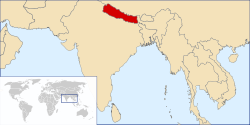| District | |
|---|---|
 | |
| Category | Jilla |
| Location | Nepal |
| Created |
|
| Number | 77 (as of 20 September 2015) |
| Populations | 2,041,587 – 5,658 |
| Areas | 7,889 square kilometres (3,046 sq mi) - 119 square kilometres (46 sq mi) |
| Government | |
| Subdivisions | |
 |
|---|
| This article is part of a series on |
| Administrative divisions of Nepal |
|---|
 |
| Federal Democratic Republic of Nepal (since 2015) |
| Nepal Portal Administrative divisions by country |
Districts in Nepal are second level of administrative divisions after provinces. Districts are subdivided into municipalities and rural municipalities. There are seven provinces and 77 districts in Nepal.
Contents
- District officials
- History
- Rana regime (1885–1950)
- Districts before 1956
- Districts from 1956 to 1962
- Panchayat era (1960–1990)
- District Development Committee (1990–2015)
- Districts under new administration
- List of districts
- Koshi Province
- Madhesh Province
- Bagmati Province
- Gandaki Province
- Lumbini Province
- Karnali Province
- Sudurpashchim Province
- See also
- References
- External links
After the 2015 reform of administrative divisions, Nawalparasi District and Rukum District were respectively divided into Parasi District and Nawalpur District, and Eastern Rukum District and Western Rukum District.










